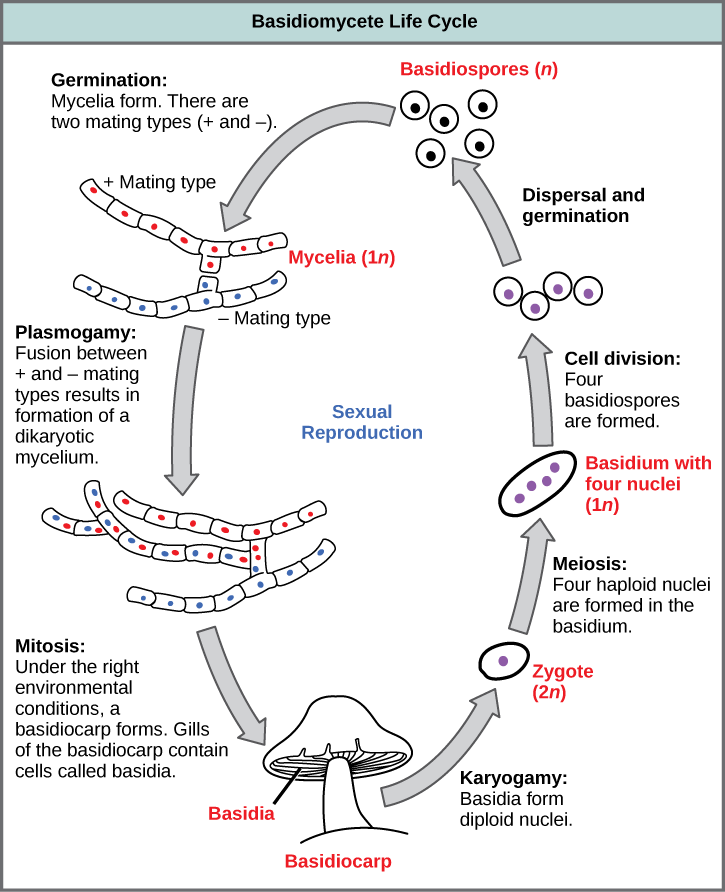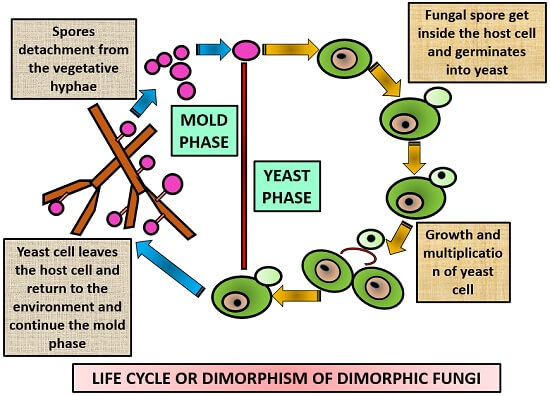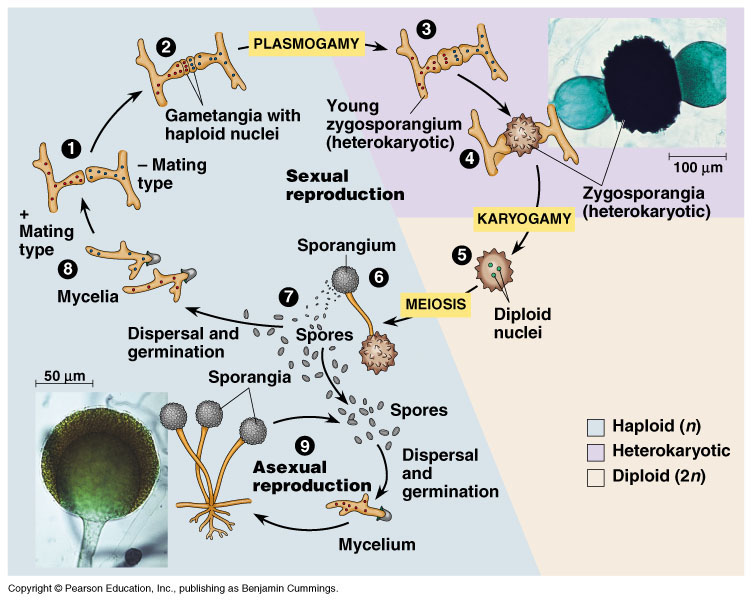fungi life cycle explained
Brundrett 1990 showed the same cycle pattern using an alternative diagram of the developmental stages of a mould. Spores produced by mature fungi are released into the surrounding environment where they divide and grow into hyphae.
In the life cycle of a sexually reproducing fungus a haploid phase alternates with a diploid phase.

. Deuteromycota alternately known as Deuteromycetes conidial fungi or mitosporic fungi is not an accepted taxonomic clade and is now taken to mean simply fungi that lack a known sexual stage. The term inoculation refers to the spores landing upon and infiltrating a growth medium sometimes known as a substrate. The mode of asexrual reproduction.
Fungi store their food in the form of starch. Great yeast bud scars and pseudohyphae. Haploid hyphae produce gametes which fuse by plasmogamy and karyogamy to produce diploid zygote.
Spores produced both. The yeast produces hyphae strands and pseudohyphae. Fungi must leave their food to find more and they do this not as hyphae but as spores.
Once the sexual union takes place sexual fruiting can occur causing more spores to repeat the cycle. The Fungi imperfecti fungi lacking the perfect or sexual stage or Deuteromycota comprise all the species that lack an observable sexual cycle. The spores exist and eventually produce mycelium causing the sexual union to occur.
These fungi are extremely important because they break down decaying matter like wood and plants and allow for their nutrients to return to the soil. Brundrett 1990 showed the same cycle pattern using an alternative diagram of the developmental stages of a mould. The generalized life cycle of fungi.
But this model provides a good overview in terms of how fungi grows from birth to death. In this article we will discuss about the life cycle of taphrina explained with the help of suitable diagrams. We have summarized them in the fungi life cycle diagram below.
Fungi reproduce sexually either through cross- or self-fertilization. The life cycle of fungi can follow many different patterns. Not all fungi reproduce the same.
By hitching a ride on another organism or even the wind these spores can travel great. Spore germ hypha mature mycelium. For most of the molds indoors fungi are considered to go through a four-stage life cycle.
Fungi can also reproduce by budding and producing spores. It involves the fusion of the hyphae of two different individuals into a mycelium. This fungus has a dimorphic life cycle with yeast and hyphal stages.
The mycelium contains haploid nuclei from both specimens. In this guide we explain the key features of some common mushrooms and provide a brief overview of the fungi life cycle. A yeast-like fungus commonly occurring on human skin in the upper respiratory alimentary and female genital tracts.
This is similar to sperm and eggs which are similar to human sex cells. This is where spores come in which are dispersed by wind and can produce a new mycelium. You can think of the spore phase as both the beginning and end of a mushrooms life.
Fungus reproduction is not very romantic. This group of fungi includes almost all mushrooms. These mushrooms are actually only one part of the organisms life cycle.
Fungi are eukaryotic non-vascular non-motile and heterotrophic organisms. This fused cell grows into the fruiting body also known as the mushroom. Both sexual and asexual fruiting can take place causing fungi to spread and expand in different areas.
Being so small and lightweight spores can easily move unseen in the air currents and most fungal spores are spread by the wind. In this article we will discuss about the life cycle of ascomycetes explained with the help of a suitable diagram. Despite their diversity in many features the Ascomycetes possess certain common unifying characteristics namely the somatic body composed of a loose indefinite mass of septate mycelium.
The pseudohyphae can give rise to yeast cells by apical or. Fungi replicate sexually andor asexually. To form n gametes n.
Sexual Fungi Life Cycle. The genus Taphrina old generic name Exoascus still in use by many authors contains several species which are very important pathogens. The fungi life cycle includes both types of reproduction for most species of fungi.
Here the haploid spores produced from zygote germinate to produce haploid mycelia. Hyphae are root-like threads composed of haploid cells. Fungus Life Cycle.
This is the first stage in the life cycle of a fungus. The budding involves the formation of a bulge on the side of the cell and the mitotic divide of the nucleus. Spore germ hypha mature mycelium.
When two hydra of opposite strain - come into contact the two cell types fuse to create one cell with two nuclei. There are four basic steps in the life cycle of a fungi. Sexual reproduction involves the fusion of two fungi.
Mushroom spores are tiny microscopic reproductive units that are produced by fungi as well as some types of plants and algae. Terms in this set 21 Fungi unique for. By producing vast numbers of spores both sexually and asexually so in TWO parts of life cycle Major difference from plants.
All fungi start as haploid spores which means they only have one copy of their genetic information. Perfect fungi are sexually and asexually replicated whereas imperfect fungi are only asexually reproduced by mitosis. The haploid phase ends with nuclear fusion and the diploid phase begins with the formation of the zygote the diploid cell resulting from fusion of two haploid sex cellsMeiosis reduction division restores the haploid number of chromosomes and initiates.
Spore Haploid The spore phase is the initial stage of the fungal life cycle. But this model provides a good overview in terms of how fungi grows from birth to death. The fungi which reproduce sexually have alternating haploid and diploid phases.
Life cycle of fungi. Life cycle of The life cycle of fungi can follow many different patterns. Spores are tiny cells that form on special hyphae and are so small that more than 1000 would easily fit on a pinhead.
This leads to the detachment of the bud from the mother cell. For most of the molds indoors fungi are considered to go through a four-stage life cycle. The majority of mold.
They induce hypertrophic malformations of buds leaves twigs flowers and fruits producing. The following sections will outline the differences between the. The formation of asexual spores is one of the most common ways of asexual reproduction.
In both sexual and asexual reproduction fungi develop spores that either fly on the wind or take a ride on an animal dispersing.

Plasmogamy An Overview Sciencedirect Topics

Difference Between Anamorph Teleomorph And Holomorph Compare The Difference Between Similar Terms

Plasmogamy An Overview Sciencedirect Topics

24 1c Fungi Reproduction Biology Libretexts

Basidiomycota The Club Fungi Biology For Majors Ii

Basidiomycota Part 2 The Mushroom Life Cycle Youtube

Intro To The Fungi Life Cycle Plantsnap

A Detailed Explanation Of The Mushroom Life Cycle Grocycle

Basidiomycota Life Cycle Study Com

Fungi Life Cycle In Basidiomycetes Youtube

Ascomycota The Sac Fungi Biology For Majors Ii

Biology Pictures Fungi Life Cycle 3 Life Cycles Plant Pathology Fungi

Zygomycota The Conjugated Fungi Biology For Majors Ii

What Is Dimorphic Fungi Dimorphic Life Cycle Examples Transmission Biology Reader


